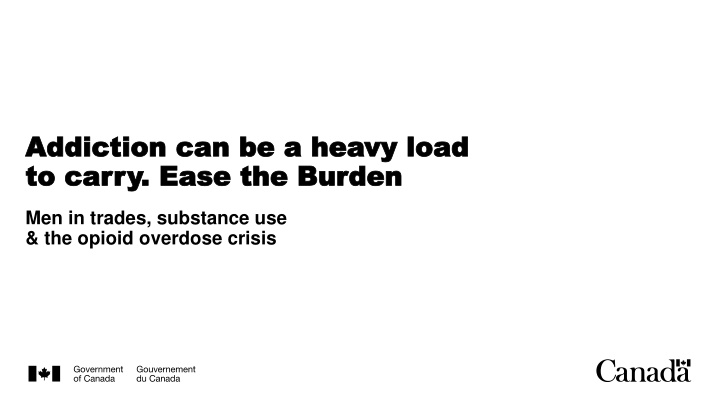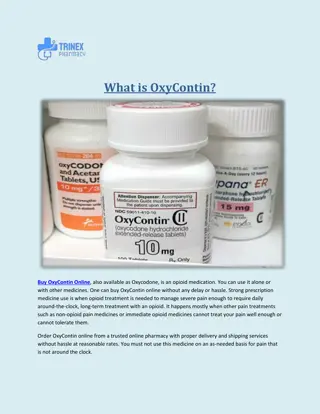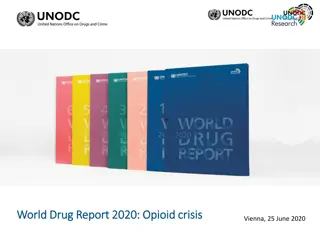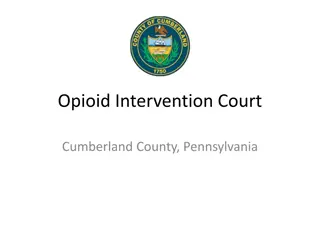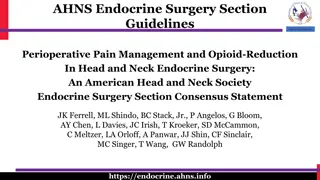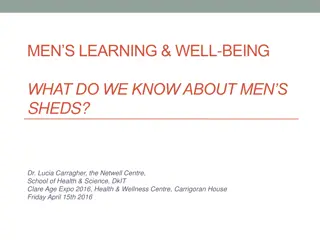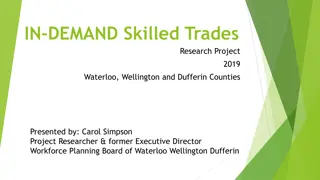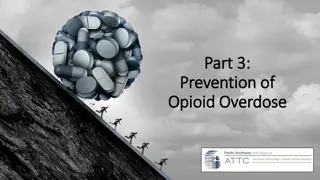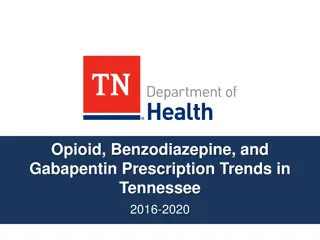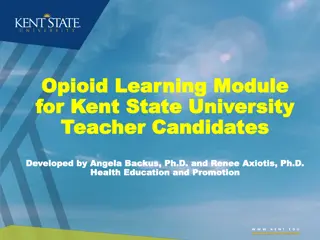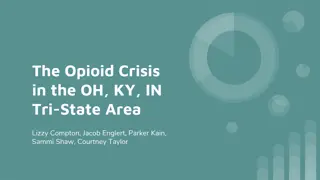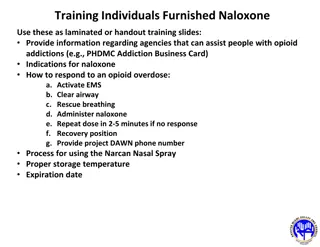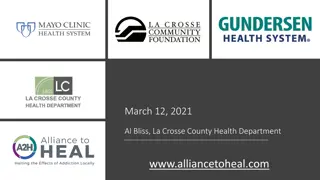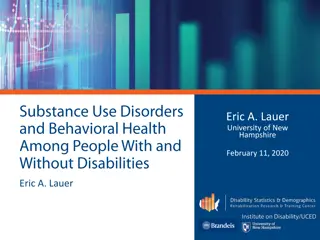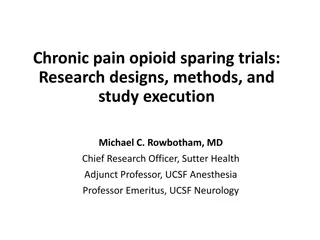Impact of Opioid Crisis on Men in Trades: Addressing Work Culture and Health Risks
The opioid overdose crisis has significantly affected men in trades, leading to a high number of opioid-related deaths and hospitalizations. This issue is exacerbated by factors such as over-reliance on pain medication, illicit drug use, and the high physical demands of their work. Men in trades often face pressure to be strong, which can deter them from seeking help for substance use and mental health issues. Addressing the impact of the opioid crisis on this population requires a holistic approach that considers work culture, health risks, and the need for support services.
Download Presentation

Please find below an Image/Link to download the presentation.
The content on the website is provided AS IS for your information and personal use only. It may not be sold, licensed, or shared on other websites without obtaining consent from the author.If you encounter any issues during the download, it is possible that the publisher has removed the file from their server.
You are allowed to download the files provided on this website for personal or commercial use, subject to the condition that they are used lawfully. All files are the property of their respective owners.
The content on the website is provided AS IS for your information and personal use only. It may not be sold, licensed, or shared on other websites without obtaining consent from the author.
E N D
Presentation Transcript
Addiction Addiction can to carry. to carry. Ease can be Ease the be a the Burden Burden a heavy heavy load load Men in trades, substance use & the opioid overdose crisis
The opioid overdose crisis 26,690 20 17 Since 2016, there have been over 26,690 opioid-related deaths in Canada On average, 20 people die per day in Canada 17 are hospitalized per day in Canada 86% In 2021, (January to September), 86% of opioid- related deaths involved fentanyl, a very strong opioid that is now being found in other illegal drugs
The chain of events 2. Increase in diverted or illegally produced opioids 1. Over-reliance on opioid prescriptions 3. Unprecedented rise in synthetic opioids (e.g., Fentanyl) 4. Fentanyl dominates illegal market & is mixed with other drugs causing toxic illegal drug supply 1. The opioid overdose crisis started by high opioid prescribing, causing some to become dependant 2. Then opioids where being illegally made and sold 3. Because of demand, strong synthetic opioids (like illegally produced fentanyl) started infiltrating the illegal market 4. Now, most opioid overdose deaths are caused by people looking for strong opioids like fentanyl, by mixing drugs or by taking other illegal drugs that contain fentanyl (sometimes without knowing)
Men in trades are disproportionally impacted Since 2016 around of opioid-related deaths were men Men in trades are overly represented: of people who were employed at the time of death, 30 50% were employed in trades
Work hard, play hard Many trades workplaces have a work hard, play hard culture, especially outside of work Men are more likely to use substances to cope with stress or mental health issues Men are less likely to reach out for help because there is a pressure to be strong
Hard, physical labour takes a toll Hard, physical labour takes a toll on the body It increases the risk of injury and can result in pain When taken properly, pain medication, like prescription opioids, can help people manage pain But some take higher doses of opioids or seek illegal opioids to keep working through pain which creates a higher risk for addiction & harms
What can you do to help? We need to talk about the impact addiction and substance use is having on our friends and coworkers Reducing the stigma of seeking help and sharing resources can help save lives Learning more about how to use prescription opioids safely, combining pain treatments, and ways to help others who may be struggling with addiction will also save lives
Addiction is a treatable medical condition. Not a choice.
Many people choose to use substances but no one chooses to become addicted.
This misconception is preventing people from asking for help.
Addiction changes the brain s reward system When someone is affected by an addiction: They experience powerful cravings for the drug (or alcohol) that are extremely hard to ignore They continue using even though it may cause harm to themselves or others The need to obtain the drug/alcohol often overtakes their normal social behaviours and their ability to get help They may be unable to stop, even if they want to
Recovery is possible Counselling peer support abstinence Medical treatment (e.g. opioid agonist therapy)
Stigma surrounding addiction can Create barriers Prevent people from asking for help Lead people to use drugs alone
How can you help? Help reduce stigma Be a buddy and support your crew Remember that addiction is a treatable medical condition, not a choice Don t judge, just listen Don t use slang such as addict and junkie Let them know that support is available Visit Canada.ca/EaseTheBurden for more resources available to you.
It takes strength to reach out for help. A lot of focus is put on being strong in physically demanding jobs People may not ask for help for fear they may be seen as weak, be judged, or get in trouble But addiction is not a choice, it s a heavy burden to carry alone We can make it easier for those who may be struggling if we share and normalize that it takes real strength to ask for help
Talking to healthcare provider about opioids Using only medications may not take away your pain Treatment options (e.g., medication, exercise, movement, physical activity, physiotherapy, massage therapy or speaking to a psychologist) are most effective when used in combination Opioids, like all medications, come with risks and potential serious side effects
Know the potential risks of using opioids Side effects: Impotence in men Nausea and vomiting Difficulty breathing Headaches, dizziness and confusion
Know the potential risks of using opioids Long-term use: Physical dependence Liver damage Worsening pain Addiction
Prescribed an opioid? Always follow the instructions Use the lowest dose possible Take for the shortest amount of time possible Ask your healthcare provider about alternatives to treating pain
You cant see, taste or smell fentanyl Fentanyl is being added to many illegal drugs
Signs of an opioid overdose? Blue lips or nails Dizziness and confusion Choking, gurgling or snoring sounds Slow, weak or no breathing Drowsiness or difficulty staying awake Can t be woken up
Naloxone can temporarily reverse the effects of an opioid overdose within 2 to 5 minutes. An overdose is always an emergency. Even if naloxone has been administered, always call for help.
Get a kit for free Take-home naloxone kits are available at most pharmacies or local health authorities No prescription is needed Go to Canada.ca/opioids and search for naloxone
The Good Samaritan law Even if you ve taken drugs or have some on you, the Good Samaritan law protects you from: simple drug possession charges violation of conditions regarding simple possession in: pre-trial release, conditional sentence, probation orders, parole In other words, you will not get in trouble if you are high or have some drugs on you if you are calling to save someone s life.
If you think that you, or a friend or family member, might need help with substance use support is available. Men in trades Canada.ca/DrugsInTheTrades Wellness Together Canada wellnesstogether.ca
